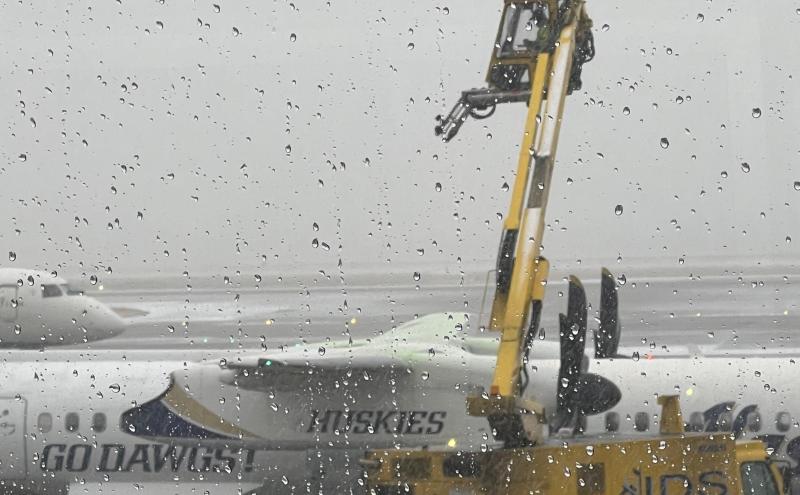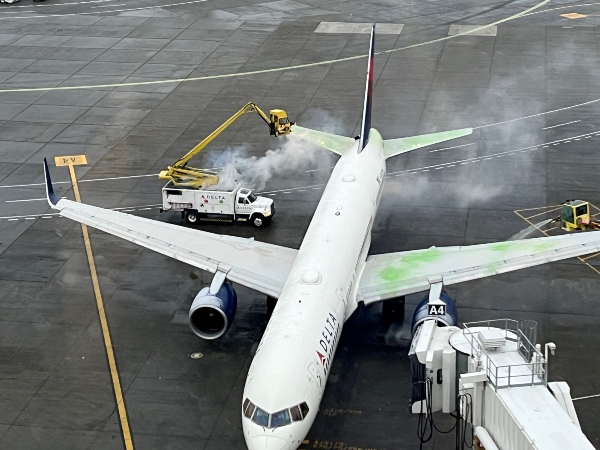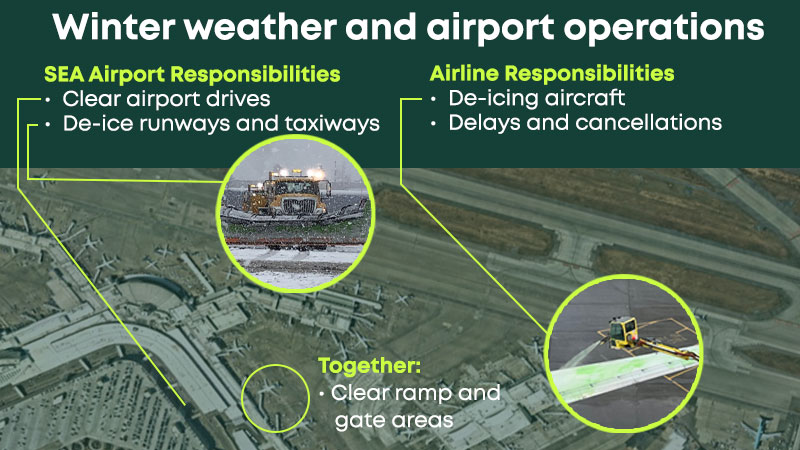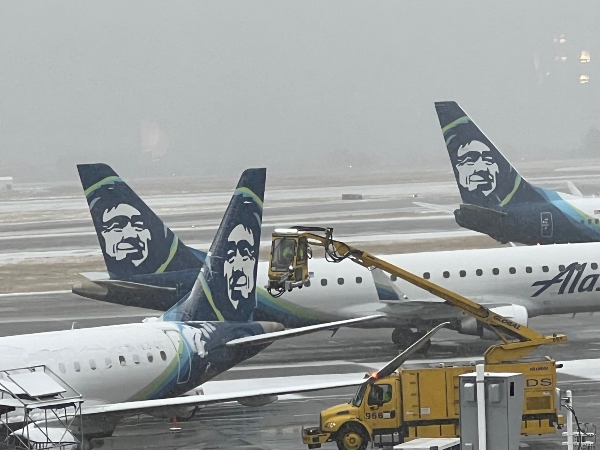
Snowstorm. Of course it happens right before your vacation. Your plane pushes back from the gate and you’re almost on your way to sunny days. But the icy crud continues to fall from the sky. And de-icing becomes an important part of your trip. The highest priority for airlines and Seattle-Tacoma International Airport (SEA) is to keep you safe. So here’s the real deal on what it is and why it’s important.
What is de-icing?
If there’s a chance of wintry weather, de-icing is an essential and required component of the flight plan. You will know that de-icing is happening when you smell the (non-toxic) smell of maple syrup.
Every airline handles their own de-icing, including purchasing, storing, and applying de-icing and anti-icing fluids to their planes. De-icing solution is a mixture of propylene glycol and water, heated to around 150 degrees, and sprayed under pressure to the wings of an aircraft. It’s good for around 22 minutes so if there are delays in takeoff, another application might be needed. De-icer removes ice and snow but can’t always prevent ice from forming again.

If ice and snow continue to fall from the sky, stage 2 of anti-icing application may be needed. Anti-icing fluid isn’t diluted with water and is a thicker consistency to stay on airplane wings during taxi and takeoff. The fluid can be colored lime green or brick red and the color fades over time to let the pilot know the effectiveness is decreasing.
If you’re worried about the environment, know that the airplane de-icing solution is collected through an industrial wastewater system and is sent for secondary treatment at a King County Treatment Plant to remove chemicals.
Why is it needed?
The short version: airplane wings are designed in a specific shape so they can take off safely. Snow and ice change the shape of the wings which can diminish the effectiveness of the wing’s lift.
Also, the Federal Aviation Administration (FAA) requires airlines and airports to de-ice and/or apply anti-icing solutions in icy conditions. We think that’s a great idea, but it does take a little extra time. Safety first!
How long could it take?
For light frost, the process could take 6-10 minutes. If it’s actively snowing, it may take 10-30 minutes depending upon the weather and the temperature and the snow consistency. Pack your patience and set your expectations for a safe — if not on time — departure. It doesn’t mean a system breakdown, just a little extra but essential work for the hard workers on a snow day and a little extra time for your journey.
Who’s holding up my departure? (aka who’s in charge?)
De-icing operations are managed by the airlines and can be the number one thing that impacts winter departures. So keep in mind that although the door to the aircraft might close at the scheduled departure time, the plane will push back from the gate and get de-iced right before your departure. Then if it’s really wintry, step 2 is anti-icing. It’s essential for everyone’s safety so maybe worth another few minutes?
What happens in winter weather? Have you planned what to do?
Is there a winter weather protocol? Absolutely. Everyone knows their place and their duties well before the first flake falls. Here’s the division of labor for winter weather at SEA Airport:
- SEA Airport maintains the terminal, airport facilities (like parking garage), runways, and getting passengers between airport facilities. That means removing ice from the airfield and runways and plowing and de-icing the parking garages. But the airport never handles de-icing planes, airplane schedules, or cancelling flights.
- Airlines manage their own flight schedules (arrivals and departures), cancelling flights and communicating with passengers, maintaining their planes, customer service and ticketing, and de-icing operations. That means planning in advance to purchase and secure enough de-icing fluids and applying it to their planes once they have pulled back from the gates. So when in doubt on anything flight- or timeline-related, contact your airline.

Where does de-icing happen?
De-icing starts when temperatures are at or below freezing or at higher temperatures with frost. Because SEA doesn’t get snow and ice like some other airports (Detroit!), SEA has a relatively small footprint for de-icing activities for the number of departing flights. De-icing can happen in a few places:
- At the gate after pushback – it needs to happen after passenger boarding because there’s a 22 minute effectiveness window before takeoff.
- Away from the gates after passenger boarding. One way to reduce delays is off-gate de-icing, where airlines can remove aircraft from the gate and de-ice at another location to allow the gate to be used for another aircraft and flight. Space is limited for off-gate deicing, but SEA has nine designated areas to expand capabilities at Taxiway Alpha. Cargo 6 and Cargo 7 can accommodate up to four narrow body aircraft each for deicing.

Other terms you may hear in a winter situation:
Gate hold
A gate hold is when aircraft are required to stay at the gate until air traffic has a spot for them to depart and is managed by the Federal Aviation Administrator or the Port. For example, an airplane can be held at the gate to apply de-icing solution before takeoff.
It doesn’t mean that the airport is closed or flights are not going in an out; the airport never closes! Instead, it means that outbound flights are being staggered for safe takeoff.
Ground stop
A ground stop can happen with low or limited visibility. It means departures are restricted from taking off until arrivals are safely on the ground.
On a typical sunny day, the airport could see 50 airplane arrivals per hour. On a hazy or foggy day, it could decrease to 28 arrivals per hour. A ground stop is a situation when aircraft cannot come to the airport due to snow or fog (or other conditions like smoke) and they are being held in another airport like Portland or San Francisco.
After airport landings are approved to begin, the next task is to get airplanes in the sky sequenced correctly and start letting them back in. “Metering” begins, which means maintaining a level of separation between planes appropriate for the conditions, and letting them land.
Every flight is different depending upon departure time, destination, and international or domestic. Don't assume that all flights are delayed — check with your airline for the most up to date information.
SEA Airport and our airline partners are committed to get you on your way safely and quickly, and to follow all winter weather protocols and best practices. Have a great flight and don’t forget to put your snow boots on for your return home. Stepping in a snow drift in flip flops is something you'll only try once.
For the long version, here are other sources about de-icing:
- CNN: Airplane de-icing: The How and Why
- The Points Guy: How Aircraft De-icing Works
- JetHead: Air Travel, De-Icing, and Delays: The Real Deal









